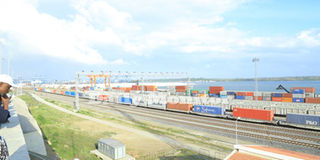Shippers seek redress from regional court over SGR use

Containers at Mombasa port. If goods are transported through the SGR, Ugandan bound cargo will be picked from Naivasha Inland Container Depot, a decision shippers have rejected because of the extra costs. PHOTO/ISMAIL MUSA LADU
What you need to know:
- The Kenyan government through the Ports Authority wants all cargo imported through Mombasa port of be hauled to Nairobi and the hinterland (Naivasha) exclusively by Standard Gauge Railway.
Ugandan shippers want their Kenyan counterparts to join them in seeking redress from regional courts to allow them choose their preferred mode of transport for cargo from Mombasa Port.
The government of Kenya through the Ports Authority wants all cargo imported through Mombasa port of be hauled to Nairobi and the hinterland (Naivasha) exclusively by Standard Gauge Railway (SGR).
When this decision was made, the importers contested thus leading to court battles with importers with Kenya Ports Authority (KPA) advocating for its stay.
However on Tuesday, KPA rushed to court and had it suspended for the second time. KPA’s reprieve was extended by Justice Eric Ogola until September 30 when a five-judge bench is expected to deliver its ruling on an application by KPA seeking a further stay for 90 days.
Speaking to this newspaper about the developments, Mr Hussien Kiddedde- the chairman Uganda Freight Forwarders Association, yesterday said: “We should align with our Kenyan counterparts to go in the regional courts of law to contest because we have a right to use the available choices of transport and not be forced,” Mr Kiddedde said.
He added that even the Kenyan private sector share the same view and will appeal through the regional courts.
“Ugandan private sector should support and escalate it through relevant authorities to take action,” he added.
Uganda as a transit route to neighbouring land-locked countries, such as Rwanda, South Sudan and Democratic Republic of Congo will face delayed delivery of goods and extra costs of doing business.
In this arrangement, once the goods are transported through the SGR, Ugandan bound cargo will be picked from Naivasha Inland Container Depot (ICD), a decision shippers have rejected because of the extra costs involved and delays.
In this arrangement, Kenya went ahead and secured land and constructed an ICD at Naivasha aimed at bringing Mombasa port closer to Uganda.
“Naivasha is a challenge to us because of its extra costs. A shipper should be able to decide what mode of transport to use because there are so many technicalities involved,” Kiddedde shared.
Ideally, when Uganda bound cargo is transported through standard gauge railway, traders will then clear their cargo from Naivasha.
Ugandan shippers have shunned this arrangement because it might affect them in the short and long-run.
Naivasha depot
Government of Kenya allocated Uganda 20 hectares of land to build an inland container port at Naivasha.
According to Kenya, the inland container depot ICD was aimed at bringing Mombasa port closer to Uganda as Kenya’s standard gauge railway will be used to bring the containers from the port to Naivasha where they will be cleared from by Ugandan traders.
Extra costs
However, according to Mr Kiddedde, the connectivity is very important.
“Whenever you break the bulk in the middle of the journey, it becomes expensive, because of additional handling costs wasted,” he added.
Ugandans collecting goods from Naivasha would lose between 12 to 36 hours due to various factors.
Shippers say since most cargo originates from Mombasa and empty containers have to be ferried to Mombasa, they still depend on trackers which is a big cost shifting their fleet from Mombasa to Naivasha.
In an earlier interview with this newspaper Mr Charles Kareba, the chairman of Uganda Shippers Council, said transporting cargo from Mombasa to Kampala ranges between $2,500 (Shs9.2m) and $3,200 (Shs 11.8m) per truck.
This cost would increase if truckers were to branch off to Naivasha and again load goods to Kampala.
“But we sidelined Naivasha because it was not making economic sense . The road to that port was too narrow for two trucks to fit. We cannot talk of the time we would waste there because the place lacked facilities,” Kareba added.




